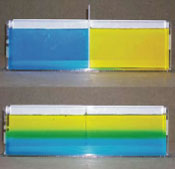Education: Activities & Documents
Effects of Temperature & Salinity on Density & Stratification (Steps 5-7)

Stratification forms an effective barrier for the exchange of nutrients and dissolved gases between the top, illuminated surface layer where phytoplankton can thrive, and the deep, nutrientrich waters. Stratification therefore has important implications for biological and biogeochemical processes in the ocean. For example, periods of increased ocean stratification have been associated with decreases in surface phytoplankton biomass. In coastal waters, prolonged periods of stratification can lead to hypoxia (low oxygen), causing mortality of fish, crabs, and other marine organisms.
This activity compares warm and cold water, demonstrating that fluids arrange into layers according to their densities. Students in grades 9-12 should read the Background section (p. 4-5) of Chapter 1 (Density) in preparation for this activity. Credit: Karp-Boss, L., E. Boss, H. Weller, J. Loftin, and J. Albright (2009). Teaching Physical Concepts in Oceanography: An Inquiry Based Approach. Oceanography 22(3), supplement, 48 pp.
teaching_phys_concepts_hi.pdf (27.0 MB)
